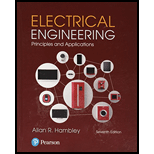
Electrical Engineering: Principles & Applications (7th Edition)
7th Edition
ISBN: 9780134484143
Author: Allan R. Hambley
Publisher: PEARSON
expand_more
expand_more
format_list_bulleted
Concept explainers
Textbook Question
Chapter 14, Problem 14.74P
When operating with an open-circuit load and with rated primary voltage, a certain 60-Hz 20kVA 8000/240-V-rms transformer has a primary current of 0.315. A rms and absorbs 360 W. Which of the elements of the equivalent circuit of Figure 14.29(b) on page729 can be determined from this data? Find the numerical values of these elements.
Expert Solution & Answer
Want to see the full answer?
Check out a sample textbook solution
Students have asked these similar questions
A transformer has primary and secondary turns of 1250 and 125 respectively. It has core cross-sectionof 36 cm2 and its rms flux density is to be limited to 1.4 T (to prevent core saturation). Whatmaximum 50 Hz voltage can be applied on the primary side and the corresponding open-circuitsecondary voltage?The core has a mean length of 150 cm and its relative permeability can be assumed to be 8000. Whatwould be the rms exciting current when the transformer’s primary winding is excited at a voltage ascalculated above? Also calculate the magnetizing susceptance as seen from primary and secondarysides.If the transformer were to be excited at 60 Hz, 1. What should be the maximum primary voltage for thecore flux density limit not to be exceeded? 2. What would be the magnetizing susceptance as seen oneach side in this case?
A transformer having a nominal voltage = 399V and a no load voltage = 420V at its secondary, the short circuit current at the secondary of this transformer in function of its nominal current will be:
Select one:
Isc=10*In
None of these
Isc=30*In
Isc=20*In
Isc=40*In
The windings of an 11500/2300V two winding transformer are connected in series, with 11500 V as the supply to the primary, to create an autotransformer. What is the voltage output of the resulting step-up autotransformer when Ip and Is are 10 A and 50 A, respectively?
Chapter 14 Solutions
Electrical Engineering: Principles & Applications (7th Edition)
Knowledge Booster
Learn more about
Need a deep-dive on the concept behind this application? Look no further. Learn more about this topic, electrical-engineering and related others by exploring similar questions and additional content below.Similar questions
- Consider an ideal transformer with N1=3000andN2=1000 turns. Let winding 1 be connected to a source whose voltage is e1(t)=100(1| t |)volts for 1t1ande1(t)=0 for | t |1 second. A2- farad capacitor is connected across winding 2. Sketch e1(t),e2(t),i1(t),andi2(t) versus time t.arrow_forwardFor a short-circuit test on a 2-winding transformer, with one winding shorted, can you apply the rated voltage on the other winding? (a) Yes (b) Noarrow_forwardAn ideal transformer with N1=1000andN2=250 is connected with an impedance Z22 across winding 2. If V1=10000VandI1=530 A, determine V2,I2,Z2, and the impedance Z2, which is the value of Z2 referred to the primary side of the transformer.arrow_forward
- When operating with an open-circuit load and with rated primary voltage, a certain 60Hz 20-kVA 8000/240-V-rms transformer has a primary current of 0.315 A rms and absorbs 360 W. Which of the elements of the equivalent circuit of Figure 14.29(b) on page 729 can be determined from this data? Find the numerical values of these elements.arrow_forwardall äabl (CME 446) 1 If F3=0.1 and Z3=45 Q, then the impedance of the next stage in the multi-section transformer is: of O a. 40.5 stion O b. 49.5 O C. 55 O d. None O e. 36.8 s page Next pagearrow_forwardThe equivalent resistance of the primary of a transformer having K = 5 and R₁ = 0.1 ohm when referred to secondary becomes ............. ohm a) 0.5 b) 0.02 c) 0.004 d) 2.5arrow_forward
- With base MVA of 150 and base voltage of 33. If the reactance of the transformer is 0.23 pu. The parameter of the reactance of the transformer in the Neplan software is O 1.66 2.30 23 0.23 O Non of themarrow_forwardI need help finding the Phasor Voltage Values of Vs, V1, and VL for this step up transformer.arrow_forwardDiscuss the relationship between the operating frequency and the transformer size? Through your engineering studiesarrow_forward
- Determine the regulation of a transformer in which thepercentage resistance drop is 1% and the percentagereactance drop is 5% when the power factor 0.8 leading.arrow_forwardA 250/125 V, five kVA single-phase transformer has a primary resistance of 0.2 ohms and reactance of 0.75 ohms. The secondary resistance is 0.05 ohm and reactance of 0.2 ohms.a) Determine its regulation while supplying full load on 0.8 leading p.f.b) The secondary terminal voltage on full load and 0.8 leading p.f.Ans.: -0.4.88%; 131.1arrow_forwardA transformer with normal voltage impressed has a flux density of 1.4 Tesla at rated frequency and a core loss comprising of 1500 W eddy current loss and 3200 W hysteresis loss. What do these losses become under when increasing the applied voltage by 12% and decreased to 68% of rated frequency. Your answerarrow_forward
arrow_back_ios
SEE MORE QUESTIONS
arrow_forward_ios
Recommended textbooks for you
 Power System Analysis and Design (MindTap Course ...Electrical EngineeringISBN:9781305632134Author:J. Duncan Glover, Thomas Overbye, Mulukutla S. SarmaPublisher:Cengage Learning
Power System Analysis and Design (MindTap Course ...Electrical EngineeringISBN:9781305632134Author:J. Duncan Glover, Thomas Overbye, Mulukutla S. SarmaPublisher:Cengage Learning

Power System Analysis and Design (MindTap Course ...
Electrical Engineering
ISBN:9781305632134
Author:J. Duncan Glover, Thomas Overbye, Mulukutla S. Sarma
Publisher:Cengage Learning
TRANSFORMERS - What They Are, How They Work, How Electricians Size Them; Author: Electrician U;https://www.youtube.com/watch?v=tXPy4OE7ApE;License: Standard Youtube License